When designing battery-powered Internet of Things (IoT) devices, the main goal is to extend the time between recharging, or to extend battery life in the case of standard batteries. There are many traditional methods, but there is a lack of a system-level perspective required to fully optimize the design.
To maximize the use of available battery power, IoT devices need to be optimized as a whole system, not as a collection of unrelated components. This article will explore the latest technologies and technologies that can be used to optimize the energy consumption of Internet of Things designs, and how best to apply them.
Traditional energy measurement methodsThe average embedded system developer is no stranger to optimizing the system's battery life. In the good old days, developers often use multimeters (such as B&K Precision  BK2706) to measure the current consumption of the embedded system. These are good multimeters that can be used to measure the average current, of course, but don't give developers the resolution they need to see fast peaks, or to measure microamperes without considerable effort. Current consumption. In order to see these rapid transitions, developers need fast things that they can easily trigger.
An oscilloscope, plus a shunt resistor of a size suitable for the current range, can be used to view these fast current transitions. Developers may use B&K Precision's BK2190. This is an excellent low-cost 100 MHz oscilloscope. Developers can of course trigger oscilloscopes to see spikes and transitions, but there are still challenges in using oscilloscopes in this particular application.
First, most low-cost oscilloscopes do not allow developers to easily access the trace. Second, the trajectory is limited in its record length. Third, oscilloscope data cannot be synchronized with events that occur on embedded systems. Taking all these three issues into consideration, developers may try their best to optimize their IoT devices within the project schedule. Therefore, a new and more modern method is needed to effectively optimize the energy consumption of IoT devices.
Use smart power to optimize energy consumptionA new, more modern way in which IoT devices can be optimized is to use smart power supplies that not only provide power to the device but also measure the voltage and current provided to the device. Smart power can be seen as a hybrid of power and data acquisition systems.
Qoitech AB Â OTIi Arc is one of the power supplies. This is a portable power supply that can be used as a current and voltage measurement unit. It is used to power IoT devices that need to be optimized for energy configuration. It transfers the collected data to the PC via USB. The OTIi Arc can also be powered via USB.
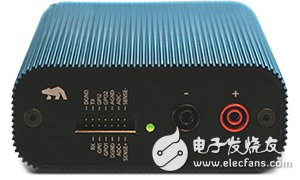
Figure 1: The OTIi Arc from Qoitech AB is a portable power supply that can be used as a current and voltage measurement unit. (Source: Qoitech AB)
The OTIi Arc can be configured with its otii software package to provide a voltage of 0.5 to 5.0 volts. When using the USB port to power the Otii Arc, the maximum output power is up to 250 mA. For most IoT devices, this will be more than sufficient, but for developers developing more power-hungry systems, an external 7.5-V to 9.0-V power supply can be used to achieve up to 2.5 amps (A) of current, and Has a maximum peak current of 5.0 A.Otii Arc  Samples can also be sampled at current resolution as low as 1 microamperes (μA) at rates up to 4 Ksamples/s, which is sufficient for most IoT devices.
Using the Otii ArcThe DUT can be connected to the Otii Arc in a variety of ways. In the first method, just like most power supplies, there are two banana plugs for powering the device. This allows developers to use a 12" red banana cable from Pomona Electronics and a voltage rail in a red Pomona fixture. Use a 12" black Pomona banana cable and a black Pomona gripper to supply the ground rail. This is the standard setting for any embedded system engineer's workbench.
The second method uses the 14-pin extension connector of the Otii Arc with a pin pitch of 0.100". This expansion port has useful connections, such as the second analog-to-digital converter (ADC) channel for measuring current, GPIO pins. And serial send and receive pin signals.
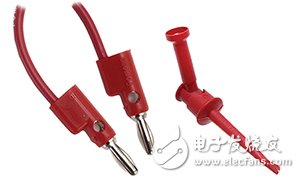
Figure 2: Connecting to the Otii Arc using a standard banana jack on almost every power supply. Developers can use 12" red Pomona Electronics banana cables and red Pomona fixtures to connect positive voltage rails to the tested IoT device (Source: Pomona Electronics)
Qoitech Otii Arc is equipped with a standard license for otii software, a visualization tool that connects to the Otii Arc to perform current and voltage measurements and control the behavior of the power supply. Visualization is used to analyze energy consumption and determine the optimal location and method of the system.
Otii software connects the power via USB and can be used to enable and disable the supply voltage or record the trace. When tracking, developers can see real-time tracking of strip chart type views that provide easy navigation. Developers can highlight areas in their tracks and provide important information such as minimum, maximum, and average current (Figure 3).
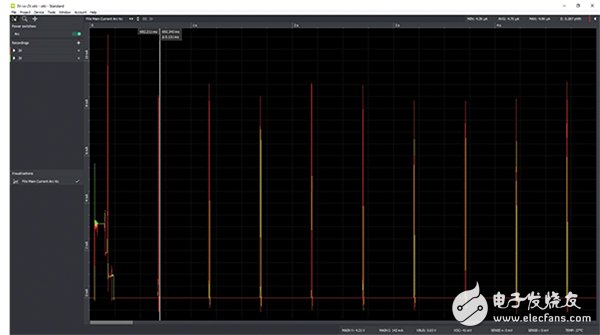
Figure 3: When tracking with Otii Arc's otii software, developers can view real-time traces displayed in a bar graph view that is easy to navigate. (Source: Digi-Key Electronics)
As discussed earlier, developers can understand the system state at various points in the trace so that they can obtain a single, coherent source of information they can analyze, which is often critical. It is also important that the smart power supply can also receive log input from the embedded system. These inputs can be used to synchronize the status.
What's interesting about the Qoitech Otii Arc is that the expansion connector can read the serial UART at a configurable baud rate and log information in tracks. A system that sets up a transmission execution log needs to receive a string log through the UART from an embedded target. To do this, connect the UART Tx pin on the IoT device to the Rx pin on the Oti Arc (Figure 4). It is a good practice to connect digitally to IoT devices to ensure that signals share the same ground reference.
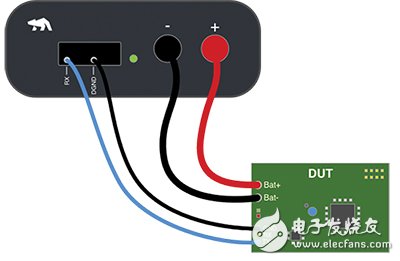
Figure 4: To receive a string log through the UART from an embedded target, connect the UART Tx pin on the IoT device to the Otii Arc  On the Rx pin. (Source: Qoitech AB)
To demonstrate how to record data in otii software, an LED toggle is displayed and the log status is provided through the UART to help developers (Figure 5).
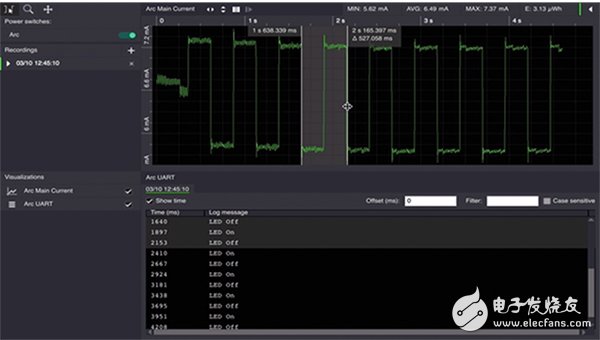
Figure 5: The Otii Arc can be set to receive UART log messages to help developers understand the state of the embedded system. In this example, the LED switches through the UART and provides log status to help the developer. (Source: Qoitech AB)
Optimize subsystem energy useThere are several ways to use smart power to optimize the energy consumption of your equipment, but they do require some upfront consideration. For example, developers should include multiple shunt resistors on their printed circuit boards so that they can connect and probe the energy consumption of different circuits. If you do not do this, you will only provide the developer with the current state of the entire system, which can make optimization a guessing game rather than an engineering activity.
Developers can use extended ADCs to monitor external shunt resistors. This resistor can monitor the Wi-Fi module, the memory chip or the microcontroller itself. This feature allows developers to adjust a single circuit while monitoring the overall system energy consumption. What the developer needs to do is set the shunt resistance value in the project settings of otii software and record the correct current in the trajectory (Figure 6).
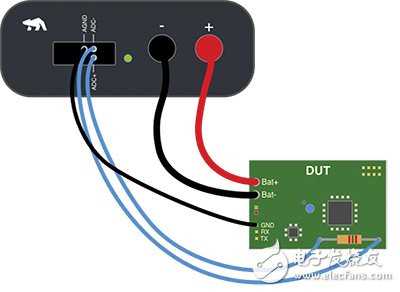
Figure 6: The Otii Arc can be set to record the system voltage and current, as well as the subsystem's second current shunt. This allows developers to adjust specific circuits while monitoring how the entire system energy consumption is affected. (Source: Qoitech AB)
There is no doubt that one of the largest energy consumers in many battery-powered IoT systems is the microcontroller. The smart power supply can be used to monitor the microcontroller, but in many cases, developers want to be able to synchronize their current measurement values ​​with the program counters in the microcontroller. This can synchronize current consumption with the line of code being executed.
To this end, developers can use smart power supplies with advanced debuggers (such as Arm's  In conjunction with Keil ULINKplus, the debugger can measure the microcontroller current and synchronize the measured value with the program counter. Then, when developers use all these measurements together, they will be able to precisely adjust their energy consumption and maximize the battery life of their IoT design.
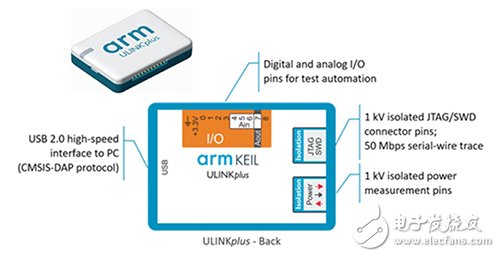
Figure 7: Arm Keil ULINKplus can be set to record the current usage of the microcontroller and synchronize this measurement with the line of code executed on the microcontroller. This helps to fully understand the energy use of IoT devices. (Source: Digi-Key Electronics)
Tips and tricks for optimizing energy consumption in the Internet of Things systemThere are several tips and tricks developers can follow to easily optimize the energy consumption of embedded systems. These include:
For each major hardware module in the design, add a shunt resistor that can be used to monitor the power consumption of the circuit during development and testing. read" Â Choose and apply the right low-power microcontroller for the IoT Â "Learn how to measure and optimize microcontroller power consumption. Put as many main system components as possible in sleep mode or low power state. Measure energy consumption throughout the development cycle, not near the end. Use can cover Apply Dynamic Range Energy Analyzers Automate the measurement process as much as possible In hardware, look for inefficient and leaky components such as LDOs and replace them with more efficient components.Optimizing the energy consumption of any IoT device is not an easy task, especially for battery-powered devices. As shown in the figure, there are several traditional energy consumption measurement methods. Using appropriate tools for proper measurement makes it easier to identify energy consumption and design IoT solutions to take full advantage of available battery power.
Shenzhen Zpal Technology Co.,Ltd , https://www.zpal-vape.com